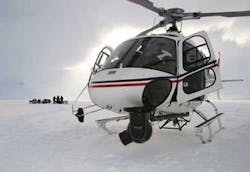DEFENSE + SECURITY 2008: Sensing a hot spot in security

A healthy attendance of 5700 bolstered a 16% increase in the number of exhibitors over last year at SPIE’s Defense + Security Symposium (DSS) 2008 at the Orlando World Center Marriott Convention Center in Orlando, FL, March 18-20. The increase in attendees and exhibitors may not just be the warm Florida weather—a run on DSS may be an effect of the end of Optics East, say organizers.
After the closing of Optics East in September 2007, SPIE (Bellingham, WA) aggregated some of the defense and sensing content from that show to Defense + Security, (previously known as AeroSense). “There seemed to be a really good match for the Optics East defense and sensing content with DSS, so it feels like a good mix for the community in the future,” said Amy Nelson, Public relations manager of SPIE. The organizers have announced a name change for the 2009 meeting, “SPIE Defense, Security, and Sensing,” to reflect the migration of sensors content.
One interesting theme threaded through the show was the emphasis on finding innovative uses of existing technology in defense and security applications. In his symposium-wide plenary presentation, Jay Cohen, Under Secretary for Science and Technology, U.S. Department of Homeland Security (DHS), told an overflow audience how his Integrated Product Team is focused on delivering technology to the department and its customers. He congratulated the attendees for their success in rolling out technology for homeland security, saying part of the challenge is detecting “hostile intent” before it happens. Low-level magnetic resonance imaging may soon be seen in airport security screening that can detect and catalog liquids found in carry-on baggage, said Cohen. Soon we may not have to remove our laptops from their cases“And that, ladies and gentlemen, is progress,” quipped Cohen.
The technology area of visual analytics, the science of analytical reasoning via visual displays, generated additional heat at the conferencespanning exploratory data analysis from posture classification to live battlefield change detection. A new “Hot Topic” session, “Visual Analytics for Homeland Defense and Security,” presented by William Tolone and William Ribarsky of the University of North Carolina at Charlotte, covered how visual displays help analysts reach insights and a more efficient understanding of vast amounts of data.
New products
In papers and in exhibits, companies focused on rolling out new products for defense and security applications. In a paper session, Paul Leisher, device engineer at nLight (Vancouver, WA), focused on the expansion of its Pearl direct-diode laser infrared countermeasure systems to include the wavelength region from 1800 to 2100 nm, in addition to previous 639, 808, 88x, and 9xx nm wavelengths. “Often solid-state lasers, of particular importance in the defense community, need pump sources in the long wavelength range of 1400 to 2100 nm, so sources should offer state-of-the-art power and efficiency over this broad range of wavelengths,” said Kirk Price, device engineer at nLight.
Lidar technology continues to be a major focus at DSS for its use in imaging and remote sensing. Three divisions of Axsys Technologies—Motion Control Products, Imaging Systems, and IR Systems—exhibited together, demonstrating their collaboration on systems for lidar and other motion-controlled imaging applications. The Imaging Systems group touted a new lidar fast-steering mirror with ±10° of scanning motion in azimuth and elevation simultaneously. The gyro-stabilized V14 HD motion-picture camera displayed in their booth, a collaboration between Axsys and Cineflex, was used in the filming of the “Planet Earth” series on the Discovery Channel (see figure).
Lasers were featured prominently in nonsensing paper sessions as well. Mikhail Maiorov, vice president of operations at Vullfort (Long Valley, NJ) gave two papers on two different laser results. In one, he presented the first high-power indium phosphide laser-diode pumps designed to accommodate the cryogenic temperatures required to pump powerful defense lasers. His group achieved a two to four times boost in power (from 9 to 11 W) in the wavelength range of 1.2 to 1.9 µm at a temperature of 80 K. In the next paper, Maiorov described how recent progress has allowed erbium- and ytterbium-doped fiber lasers to reach power levels of several kilowatts. The researchers demonstrated several diode modules, among them a 976 nm pump module with 55 W of output power from a 105-µm-core-diameter fiber with a coupling efficiency of 58%, and came to the conclusion that there is no single, universal architecture for high-brightness high-efficiency pump modules.
The Symposium, with its new name, will return to Orlando April 13-17 next year.

Valerie Coffey-Rosich | Contributing Editor
Valerie Coffey-Rosich is a freelance science and technology writer and editor and a contributing editor for Laser Focus World; she previously served as an Associate Technical Editor (2000-2003) and a Senior Technical Editor (2007-2008) for Laser Focus World.
Valerie holds a BS in physics from the University of Nevada, Reno, and an MA in astronomy from Boston University. She specializes in editing and writing about optics, photonics, astronomy, and physics in academic, reference, and business-to-business publications. In addition to Laser Focus World, her work has appeared online and in print for clients such as the American Institute of Physics, American Heritage Dictionary, BioPhotonics, Encyclopedia Britannica, EuroPhotonics, the Optical Society of America, Photonics Focus, Photonics Spectra, Sky & Telescope, and many others. She is based in Palm Springs, California.